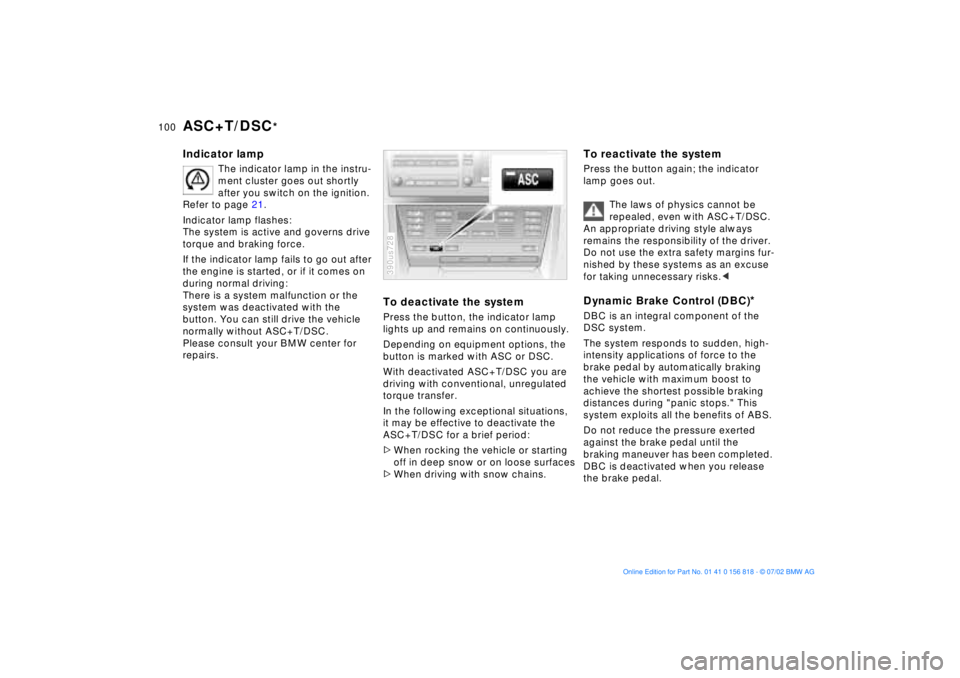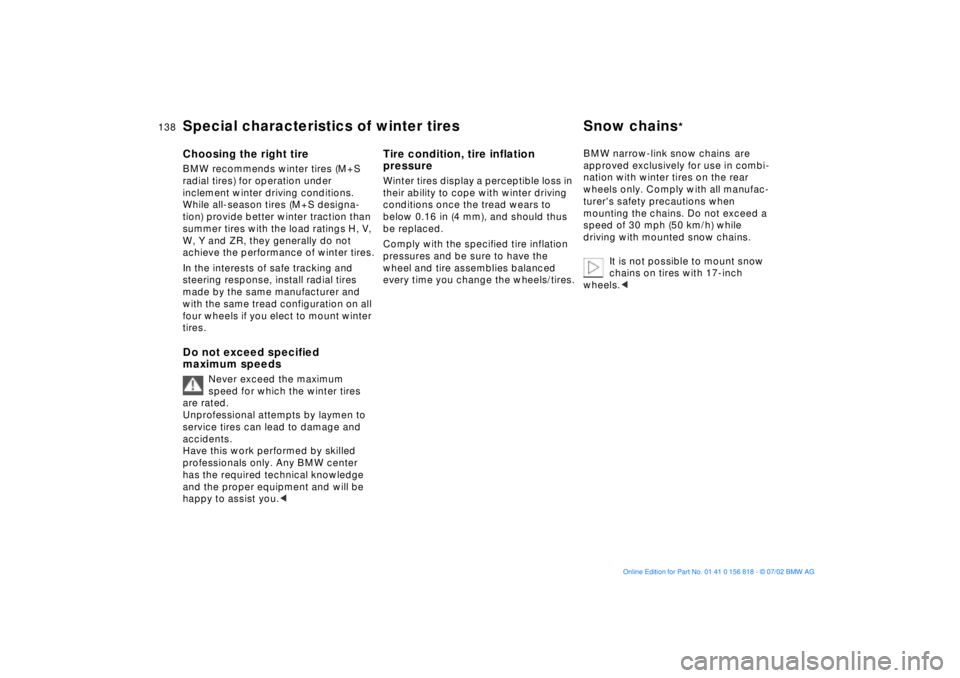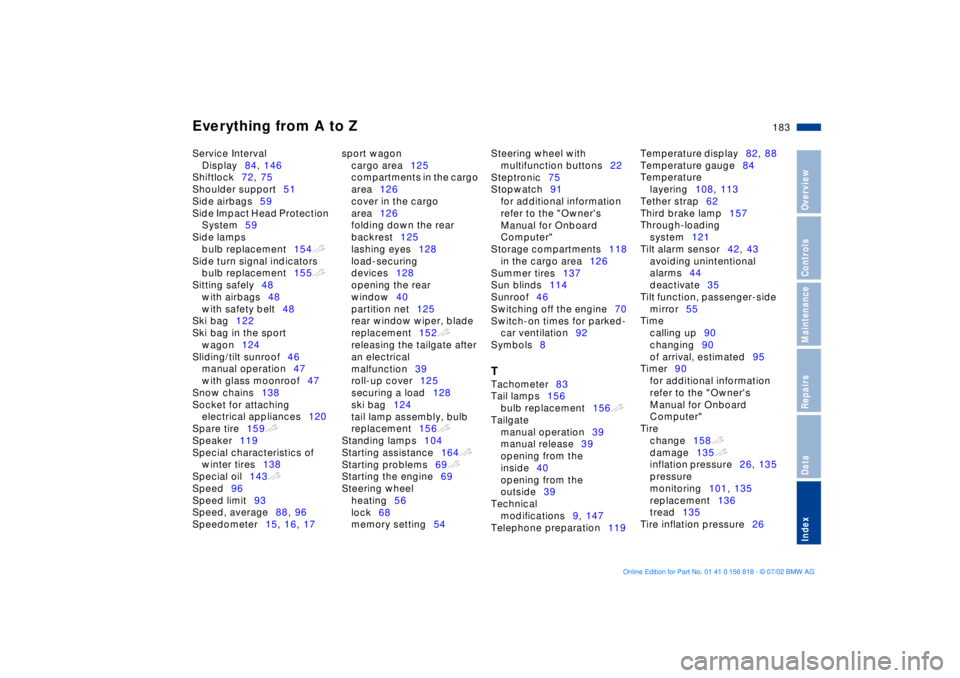2003 BMW 540I SEDAN snow chains
[x] Cancel search: snow chainsPage 6 of 187

Contents
Operation, maintenance
Owner service procedures
Special operating instructions:
Break-in procedures132
Driving notes133
Antilock Brake System133
Brake system134
Wheels and tires:
Tire inflation pressure135
Tire condition135
Tire replacement136
Wheel and tire
combinations137
Special characteristics of winter
tires138
Snow chains138
Under the hood:
Hood139
Engine compartment
essentials140
Washer fluids141
Engine oil142
Coolant144
Brake fluid145
Maintenance:
The BMW Maintenance
System146
Laws and regulations:
Technical modifications147
California Proposition
65 Warning147
OBD interface socket148
Replacement procedures:
Onboard tool kit152
Windshield wiper blades152
Lamps and bulbs153
Changing a wheel158
Battery162
Fuses162
Assistance, giving and
receiving:
Jump-starting164
Towing the vehicle165
Page 100 of 187

100n
ASC+T/DSC
*
Indicator lamp
The indicator lamp in the instru-
ment cluster goes out shortly
after you switch on the ignition.
Refer to page 21.
Indicator lamp flashes:
The system is active and governs drive
torque and braking force.
If the indicator lamp fails to go out after
the engine is started, or if it comes on
during normal driving:
There is a system malfunction or the
system was deactivated with the
button. You can still drive the vehicle
normally without ASC+T/DSC.
Please consult your BMW center for
repairs.
To deactivate the systemPress the button, the indicator lamp
lights up and remains on continuously.
Depending on equipment options, the
button is marked with ASC or DSC.
With deactivated ASC+T/DSC you are
driving with conventional, unregulated
torque transfer.
In the following exceptional situations,
it may be effective to deactivate the
ASC+T/DSC for a brief period:
>When rocking the vehicle or starting
off in deep snow or on loose surfaces
>When driving with snow chains.390us728
To reactivate the systemPress the button again; the indicator
lamp goes out.
The laws of physics cannot be
repealed, even with ASC+T/DSC.
An appropriate driving style always
remains the responsibility of the driver.
Do not use the extra safety margins fur-
nished by these systems as an excuse
for taking unnecessary risks.< Dynamic Brake Control (DBC)
*
DBC is an integral component of the
DSC system.
The system responds to sudden, high-
intensity applications of force to the
brake pedal by automatically braking
the vehicle with maximum boost to
achieve the shortest possible braking
distances during "panic stops." This
system exploits all the benefits of ABS.
Do not reduce the pressure exerted
against the brake pedal until the
braking maneuver has been completed.
DBC is deactivated when you release
the brake pedal.
Page 138 of 187

138n
Special characteristics of winter tires Snow chains
*
Choosing the right tireBMW recommends winter tires (M+S
radial tires) for operation under
inclement winter driving conditions.
While all-season tires (M+S designa-
tion) provide better winter traction than
summer tires with the load ratings H, V,
W, Y and ZR, they generally do not
achieve the performance of winter tires.
In the interests of safe tracking and
steering response, install radial tires
made by the same manufacturer and
with the same tread configuration on all
four wheels if you elect to mount winter
tires.Do not exceed specified
maximum speeds
Never exceed the maximum
speed for which the winter tires
are rated.
Unprofessional attempts by laymen to
service tires can lead to damage and
accidents.
Have this work performed by skilled
professionals only. Any BMW center
has the required technical knowledge
and the proper equipment and will be
happy to assist you.<
Tire condition, tire inflation
pressureWinter tires display a perceptible loss in
their ability to cope with winter driving
conditions once the tread wears to
below 0.16 in (4 mm), and should thus
be replaced.
Comply with the specified tire inflation
pressures and be sure to have the
wheel and tire assemblies balanced
every time you change the wheels/tires.BMW narrow-link snow chains
are
approved exclusively for use in combi-
nation with winter tires on the rear
wheels only. Comply with all manufac-
turer's safety precautions when
mounting the chains. Do not exceed a
speed of 30 mph (50 km/h) while
driving with mounted snow chains.
It is not possible to mount snow
chains on tires with 17-inch
wheels.<
Page 165 of 187

165n
OverviewControlsMaintenanceRepairsDataIndex
Jump-starting Towing the vehicle7. Start the support vehicle's engine
and let it run at an increased idling
speed for a few minutes. Start the
engine on the vehicle needing the
jump-start, and allow it to run as
usual. If the first start attempt is not
successful, wait a few minutes
before another attempt in order to
allow the discharged battery to
recharge
8. Before disconnecting the jumper
cables let the engines run for a few
minutes
9. Then disconnect the jumper cables
in reverse sequence.
Depending on the cause of the fault,
have the battery recharged by your
BMW center.
Tow fittingThe screw-in tow fitting is stored in the
onboard tool kit; be sure that it remains
in the vehicle at all times. This fitting is
designed for installation in the tow
sockets located at the front and rear of
the vehicle, and is intended for towing
on paved road surfaces only.
It should not be used to pull a vehicle
out of deep snow, mud, sand, etc.
Always observe all applicable towing
laws and regulations.Access to tow socketsFront:
Apply pressure to the arrow symbol on
the cover panel to remove.390de087
Rear:
Apply pressure to the arrow symbol on
the cover panel to remove.
Screw the tow fitting in until it bot-
toms firmly. Failure to screw the
fitting all the way in can cause thread
damage.
Never attach tie-down hooks, chains,
straps, or tow hooks to tie rods, control
arms, or any other part of the vehicle
suspension, as severe damage to these
components will occur, leading to pos-
sible accidents.<
Use only a nylon towing strap to tow
the vehicle, since the inherent resil-
ience of this material helps protect both
vehicles from sudden jerking move-
ments.394de088
Page 183 of 187

Everything from A to Z
183n
OverviewControlsMaintenanceRepairsDataIndex
Service Interval
Display84, 146
Shiftlock72, 75
Shoulder support51
Side airbags59
Side Impact Head Protection
System59
Side lamps
bulb replacement154t
Side turn signal indicators
bulb replacement155t
Sitting safely48
with airbags48
with safety belt48
Ski bag122
Ski bag in the sport
wagon124
Sliding/tilt sunroof46
manual operation47
with glass moonroof47
Snow chains138
Socket for attaching
electrical appliances120
Spare tire159t
Speaker119
Special characteristics of
winter tires138
Special oil143t
Speed96
Speed limit93
Speed, average88, 96
Speedometer15, 16, 17 sport wagon
cargo area125
compartments in the cargo
area126
cover in the cargo
area126
folding down the rear
backrest125
lashing eyes128
load-securing
devices128
opening the rear
window40
partition net125
rear window wiper, blade
replacement152t
releasing the tailgate after
an electrical
malfunction39
roll-up cover125
securing a load128
ski bag124
tail lamp assembly, bulb
replacement156t
Standing lamps104
Starting assistance164t
Starting problems69t
Starting the engine69
Steering wheel
heating56
lock68
memory setting54 Steering wheel with
multifunction buttons22
Steptronic75
Stopwatch91
for additional information
refer to the "Owner's
Manual for Onboard
Computer"
Storage compartments118
in the cargo area126
Summer tires137
Sun blinds114
Sunroof46
Switching off the engine70
Switch-on times for parked-
car ventilation92
Symbols8
T
Tachometer83
Tail lamps156
bulb replacement156t
Tailgate
manual operation39
manual release39
opening from the
inside40
opening from the
outside39
Technical
modifications9, 147
Telephone preparation119 Temperature display82, 88
Temperature gauge84
Temperature
layering108, 113
Tether strap62
Third brake lamp157
Through-loading
system121
Tilt alarm sensor42, 43
avoiding unintentional
alarms44
deactivate35
Tilt function, passenger-side
mirror55
Time
calling up90
changing90
of arrival, estimated95
Timer90
for additional information
refer to the "Owner's
Manual for Onboard
Computer"
Tire
change158t
damage135t
inflation pressure26, 135
pressure
monitoring101, 135
replacement136
tread135
Tire inflation pressure26